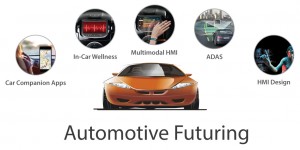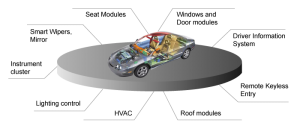Text: Bhargav TS
Bangalore-based Tata Elxsi, a part of the Tata Group is taking up the challenges that the automotive industry is currently facing. Automotive electronics, one of the megatrend that is being talked witnesses more innovations around the globe. Tata Elxsi on its part developing many technologies and supporting the Indian and global OEMs. The company currently working on an open source technology platform Genivi that supports lot of technology inputs and exhibit what every technology feed brings out in the vehicle. Being an open source, the software is easily accessible and the technology especially in India will always float on the cost which is considered as the bedrock. Hence a different approach should be manipulated where the necessities and need of technologies should be advocated and strategise the same to make the customers sense the value of it. The market insights and information will nourish the customers with the requisites and need will be felt.
Speaking about the Genivi platform Ashish Khushu, Vice President and Head – Transportation Business Unit, Tata Elxsi coded that, “As part of our competency, we at Tata Elxsi see ourselves involved more and more in projects with Genivi compliance or developing application software for Genivi platforms, which shows how much the industry is open towards new ideas. In a cost centric market like India, it is required to understand the customer’s standpoint before coming up with the technology. Hence in many a case we have aided the client with market insights, that could influence the whole perception of the product, right from requirement elicitation.” It is to be noted that many OEMs and suppliers have started investing in Genivi.
Infotainment space is going through a lot of changes. It propels the broad adoption of non-differentiating software (middleware and OS), thus driving the industry to innovate in their specific differentiating software. Google and Apple enter the automotive infotainment scene with Google GAL and CarPlay in the middleware and they are easily accepted by the market. Tata Elxsi as part of its engagement with a global tier 1 has successfully integrated Apple CarPlay and Google for their latest infotainment system. This technology helps in integrating phone with the dashboard of the car.
Smart phone’s encroachment to the car can make Car Connectivity Apps in entertainment, vehicle info, PEPS (Passive Entry Passive Start) systems thus editing the infotainment page. Responsive HMI screens are in parallel to satiate the customer demands as responsive mantra is viral now with devices of specific dimensions. Along with the industrial designing team the company is catering to multiple customers with crisp user experience interfaces, with the market trend leaning towards multimodal HMIs with voice and gesture.
Speaking about the vision based system Khushu pointed that, “As part of our capability building, we have developed a vision based automated validation system called AutomaTE which is piquing interest since validation has become a tedious task for testing complex systems. We can also see the convergence of technologies towards future concepts like the connected car which will see WiFi, live media streaming and safety and security with telematics functions like V2X and fleet management ruling your dashboard.”
Automotive is one of the most happening industries with so many technologies and ideas coming into the main stage. Even though this is the case, the Indian industry lag behind other foreign markets in terms of technology adoption, capacity to meet the demand and R&D capability, pointed out Khushu. He further said, with an estimated 200 million people likely to be added to India’s urban population by 2020 (inputs taken from Ernst & Young report) more pressure will be piled on an already strained transport infrastructure. For newer technologies like telematics and V2X to catch up, India should come up with the required infrastructure development. The government should lead this campaign by facilitating constructive development, thus shaping a smart India empowered with technology.
Safety and security, although has been around for some time, in a developing market with strict competition, customers have been demanding for better technology at lower prices.This along with the strict regulations placed by various governments on mandatory safety requirements such as crash test standards like the one that the Indian government recently introduced – NCAP (New Car Assessment Program) on new cars, are hard pushing the OEMs to come up with better designs in a cost efficient way. The winds of change is reflected throughout the market. Tata Elxsi senses the higher adoption rate of ADAS technologies like night vision, pedestrian detection systems and adaptive headlights in the local market, thus introducing far advanced electronic systems in the car making it intelligent to predict and prevent accidents.
Khushu revealed that “We are involved quite deeply in the ADAS sector by engineering adaptive lighting, valet parking systems and proximity warning, which has greater traction among the customers – both Indian and International. We also provide algorithm development services and PoC buildup, for many suppliers who have been venturing into this exciting piece of technology, with strong possibilities of growth. Data safety also underlines its insecurity with potential threats like hacking and software crashes. The design of security architecture should see to that the car is constantly communicating and transacting with networks external to the car.”
Another major development in driver safety is the large role that Telematics has to play. Though it is still taking its baby steps in India, telematics is globally making waves, with features like the eCalls being mandatory in every car according to the new State Regulation in Europe. Telematics features like fleet management, driver monitoring, Health insurance, driver behavior, WiFi connectivity, eCalls and have high adoption rates in foreign markets in which the company has a part play in enabling the technology. In India, telematics technology has slowly started finding its footing, by appearing in public transport and taxi services in the form of safety apps and driver monitoring systems. Hopefully this is bound to catch up and thus help in bringing down the number of accidents that has been plaguing the nation.
Contrary to traditional concept, a car has grown into a complex system packed with electronics in every possible area. “From being a mere mechanical machine, it has transformed into this big computer on wheels with millions of lines of code running on it. Driver comfort and safety has been the greatest target and the industry is trying to reach this goal by investing heavily on sensors and vision based systems. With an average number of 40 ECUs per vehicle and counting, we are yet to see a new direction in this sector that could give better results with the use of electronics. The proportion of electronics in commercial vehicles will also grow in a faster pace and the need is sensed by now,” he added.
Commenting on the emerging technologies Khushu stated that, “We at Tata Elxsi believe that the role of electronics and software in cars will rise even more, thus driving towards remarkable changes in the Car Architecture. This could also trigger huge makeovers in the demands and aptitude of the consumers. As a technology company, we mean to constantly update and understand the industry, through our committed R&D department, thus being in step with the revolution that is taking place around us. We have dedicated teams who work on emerging technologies to conceptualise and implement novel technologies which will converge towards inventive ideas like Connected Car and Autonomous driving.”
The company has put their hands in powertrain module too. Powertrain serves as the brain of the engine in a modern car which controls many sensors. Driver info is one of the newer concepts, which empowers the driver with valuable information of the car and the driving environment. This is ensured by a combination of the infotainment system, HMI, HUD and countless sensors which provides alerts on vehicle health, service alerts, collision and proximity detection, traffic alerts and lane departure warning.
Averring on the autonomous vehicle Khushu pointed that, “We have been closely involved with automotive electronics for over 15 years and over this period we have participated very actively in the adoption and evolution of electronics technology in cars. Also, Tata Elxsi has dedicated competencies for advanced driver assistance technologies, through which we have catered to multiple customers worldwide. We feel that these technologies which ensure safety to every driver will eventually mature towards autonomous driving, which is a very exciting, and technologically challenging idea that requires the highest degree of innovation and experimentation. For making this a reality, each and every department of an automobile should undergo a complete transformation, engaging the passenger in every way possible. Thus futuristic infotainment systems and V2X technology are possible enablers for this revolution. We at Tata Elxsi has been envisioning such a future and have been involved deeply in each of these departments. Through internal initiatives to understand and learn better technologies, we have invested in next generation technologies thus ramping up for the future. Making Autonomous driving possible is going to be a complex road ahead, due to many problems in technology compliance. Nevertheless, we accept that as a challenge while working on various projects with our customers which will enable this change, utilising our strong engineering talent who have made significant progress thus establishing our capability in this area.”













Leave a Reply